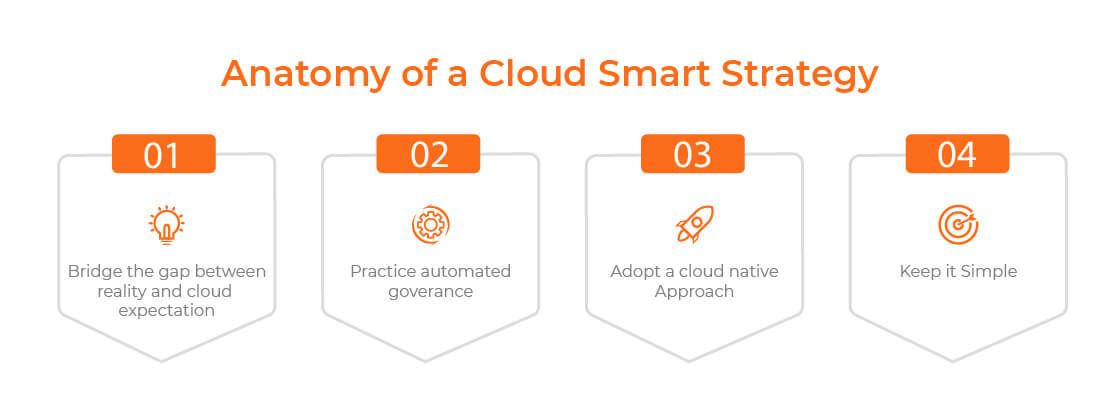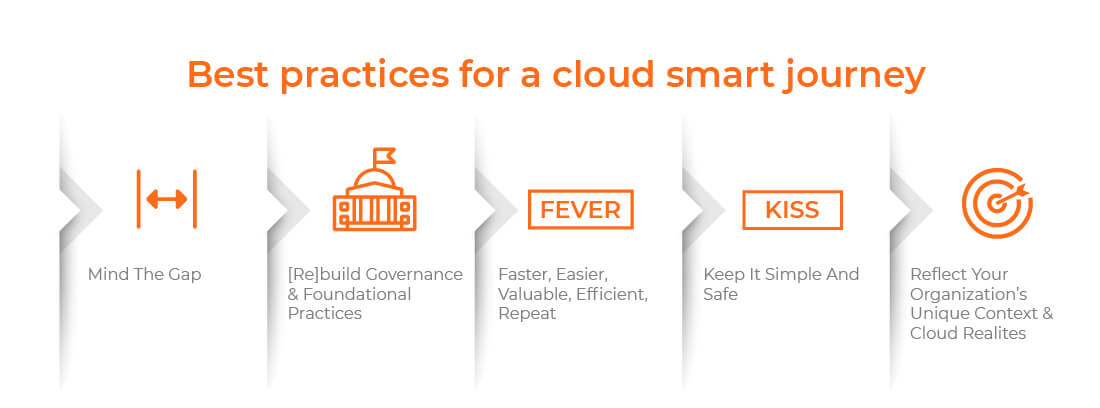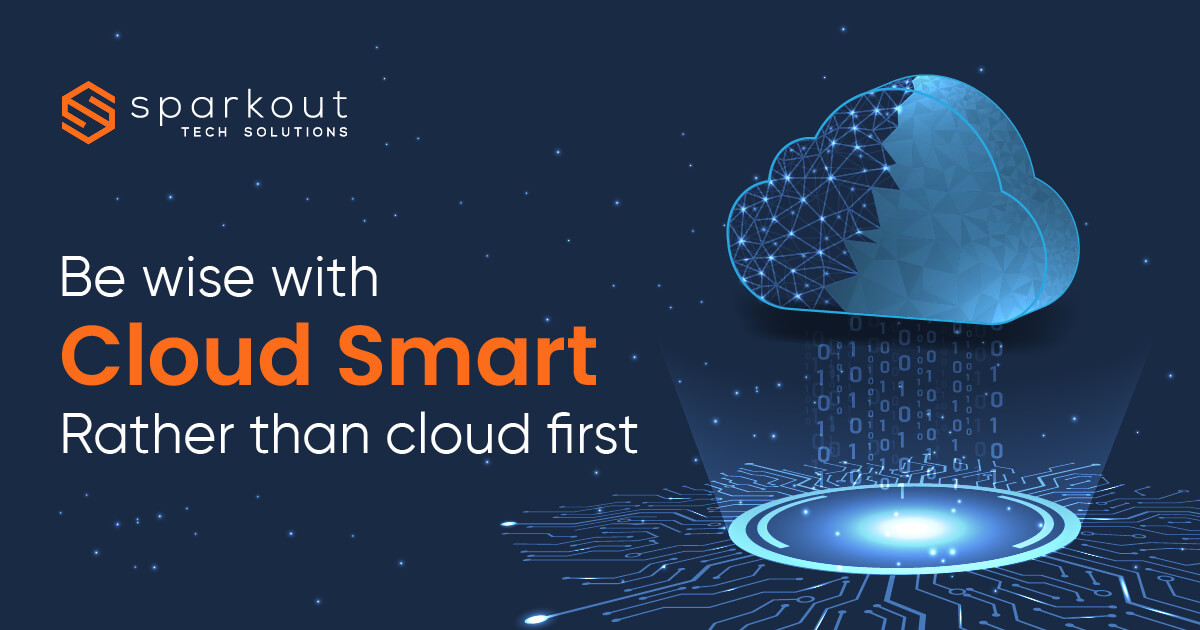A few years ago, "Cloud" was merely a buzzword in the tech industry, but now it's a hot topic. In fact, it is already clear that the clouds are invading enterprise data centres all over the world, and this trend is only expected to grow. Cloud services have developed over time, just like most technologies, adding features and complexity that may complicate the rush to the cloud and raise the risk.
The transformative, cultural, and organizational developments that are being generated by cloud technology also force organizations to examine their strategy to reflect the realities of the moment. As businesses seek to advance digital transformation and modernization, cloud-first has been the leading approach to cloud adoption initiatives for almost ten years. Cloud-smart businesses balance cloud adoption with their unique circumstances, objectives, and business value. More than 60% of businesses that currently use a cloud-first strategy will switch to a cloud-smart by 2023. If you’re not already making the move to the cloud, here’s why you should move to the cloud smart rather than the cloud first.
What is the Cloud First Strategy ?
A business using a cloud-first strategy should always look first at cloud computing solutions when trying to address new or existing processes. This strategy can help companies get the most out of their investment by encouraging companies to explore the possibilities of what the cloud can do for them.
Benefits of a cloud-first strategy
- Flexibility: Develop your systems progressively to meet business requirements.
- Less overhead: Using on-premises server solutions results in an overhead of equipment and maintenance costs that can be reduced or even eliminated by adopting a cloud-first strategy.
- More resources: Access to additional services, which often require a minimal or no initial investment, is provided by cloud vendors.
- Cost-effective upgrades: Cloud vendors provide a range of pricing options that you can use to reduce the cost of upgrades that are performed on demand.
- Support: Cloud service providers offer knowledgeable support for their services.
- Quick release: Working directly in the cloud can help you provide fixes, upgrades, and updates more quickly.
- Collaboration: Cloud services frequently provide collaboration solutions that let you operate remotely, accessing tools, storage, and data from a variety of device types.
What Does "Cloud Smart" Mean?

Being cloud smart means understanding the benefits of cloud computing and how your company can use it efficiently by staying ahead of the cloud. Furthermore, it means identifying the most appropriate cloud services for your requirements, from Infrastructure as a Service (IaaS) to Software as a Service (SaaS), along with learning how to manage and secure those services properly. Cloud-smart is fundamentally about utilising the benefits of the cloud to increase your company's efficiency, agility, and scalability. Moreover, it is about understanding how to use emerging technologies such as machine learning and automation to streamline digital workflows and improve productivity.
If you want to compete effectively in today's rapidly changing environment, it is important to have a cloud-smart strategy.
The Benefits of Cloud Smart strategy
There are huge benefits to becoming cloud-smart, including:
- Improved Efficiency: By automating tasks and procedures, cloud computing can help businesses become more efficient. For example, you can use the cloud to automatically update software applications, schedule data backups, and even share weekly work plan templates to manage your project pipeline and project objectives.
- Greater Agility: The cloud allows businesses to scale up and down as needed. As a result, businesses may more quickly adapt to market changes and respond to new possibilities or challenges.
- Enhanced Scalability: The cloud also allows businesses to simply add or remove resources as needed to maximise resource leveling and stay ahead of changing needs while maintaining profitability.
There are many other benefits to being cloud-smart, from cost reductions to improved integrated project management. Cloud smartness should be at the top of your list of things to include in your company culture if you want to stay ahead in today's fast-paced business world.
4 Best practices to implement cloud computing into your business

Businesses must have a cloud-smart strategy as cloud adoption increases. Here are some best practices for implementing cloud computing into your business.
Reduce the disparity between reality and cloud expectations
Unfortunately, many businesses misjudge the costs and difficulties of switching to the cloud. It may result in incorrect expectations of what cloud technology can provide.
To confirm that your company's cloud smart strategy is on track, discover gaps between the reality of your present IT environment and your cloud migration goals.
One way is to do a cloud readiness assessment.
It will help you to understand the dependencies, hazards, and restrictions of your current on-premises IT infrastructure. Furthermore, it will provide insight into which technologies and processes must be in place before moving to the cloud.
Using Automated Governance
Cloud services offer many more configuration choices than their on-premise counterparts. As a result, it's essential to have automatic controls in place to keep your cloud environment stable and safe.
Companies should set up a CCOE (cloud centre of excellence) with automated processes for routine management tasks like policy modifications and patching. These tasks can be automated to help reduce errors that could result in downtime or security incidents.
Furthermore, common cloud service catalogues and service-level agreements (SLAs) are required. It will improve insight into your IT operations and enable greater consistency across your cloud deployments. CCOE's three important pillars are as follows:
- Governance: Refers to the policies, duties, and obligations that an organization has in place around cloud usage. Making governance a priority promotes optimal operational and financial performance.
- Community: The community pillar facilitates user collaboration by providing resources such as a source-code repository, a knowledge base, and forums.
- Brokerage: The purpose of this pillar is to make it easier for users to identify and evaluate cloud services that fit their specific requirements. It makes it easier for users to choose cloud solutions and cloud providers.
Adopt a Cloud-Native Strategy
To effectively capture the benefits of the cloud, you must adopt a cloud-native approach that includes working with SaaS and PaaS tools.
Companies can accomplish this by implementing DevOps approaches such as continuous integration and delivery, cloud-agnostic microservices architecture, and open-source infrastructure automation tools (e.g., Ansible or Puppet).
This can be done in stages. For example, in the first step, you concentrate on cost-effective workloads and migrate them to the cloud. Then, in the second stage, you can concentrate on application migration. Finally, in the third stage, you can migrate all of your workloads to the cloud and take a true cloud-native strategy.
Keep it simple
When it comes to your cloud-smart strategy, simplicity is essential. Rather than trying to handle too many things at once, concentrate on the essential features required to produce value for your business.
It will help you create a solid cloud strategy that can be gradually and successfully deployed over time. In this aspect, the KISS approach serves a purpose.
KISS (keep it simple, stupid) is a software development principle. It suggests that when creating software, you should avoid unnecessary complexity. The same logic applies to your cloud strategy.
Why should you switch to Cloud Smart Strategy?
A cloud-smart strategy has various advantages. However, the purpose of a cloud smart strategy is to provide environments with the optimum strategy for their needs, which does not always require a total migration to the cloud. A cloud-smart strategy enables businesses to manage their processes in a more holistic manner. Rather than using a single platform to host all of their applications, storage, and processes, they assess each and choose which will perform effectively on which platform.
This will allow your business to take full advantage of many features such as functionality, performance, agility, memory, security, and more as needed. Furthermore, as companies demand change, a cloud-smart strategy enables businesses to transition from the cloud to on-premises and vice versa. While this requires a team that is continually assessing the company's needs and mission, it will mean that you are constantly aligned with cloud best practices that are unique to your company rather than what may appear to be good initially but may be negative later on.
Cloud-Smart vs Cloud-First: Which Strategy to Choose?
| Cloud first strategy | Cloud smart strategy |
|---|---|
| Unrestricted access to resources such as software and platforms | Access to managed cloud services and platforms without relying entirely on third-party providers. With the loss of control, every support is on standby. |
| Modernization of all systems will facilitate future updates and integration. | The ability to allocate resources only as needed to different channels, ensuring a clear understanding of expenditure and accompanying benefits. |
| Reduce the cost of infrastructure and maintenance instantly | The ability to choose which hardware is helpful to company activities and required for existing systems. |
| Speed has increased | The ability to extend into cloud usage as needed based on what will help certain systems and applications at the moment. |
| Managed Cloud Services that are simplified and do not require in-house expertise; a vendor who will manage repairs, updates, and improvements for you. | The ability to fully explore hybrid cloud strategies based on business requirements, shifting from on-premises to cloud and vice versa, based on where the business is and what is most favourable to its growth at the time. |
To end things off,
If businesses follow the right strategy, there is no real right or wrong plan. Both the Cloud First and Cloud Smart initiatives provide a variety of benefits, depending on your company's success and how you intend to fulfil them. Cloud Smart is definitely the more long-term choice. It provides you with an opportunity (or obligation, depending on your perspective to regularly examine whether the infrastructure you're employing is still appropriate for your business and helps its growth. If it is too expensive and exceeds your budget, or if your systems are obsolete and require adaptation to perform in a cloud environment, the Cloud Smart strategy will provide the answers before you overcommit.
 Translate
Translate


















Author Bio
Yokesh Sankar
CO-Founder
Yokesh Sankar is the co-founder and chief operating officer of Sparkout Tech. He believes in changing people's lives for the better and developing the skills they need for success, and that the software industry has endless possibilities to streamline virtually any industry you can imagine. In addition, he is also an advocate for the adoption of blockchain technology, helping businesses of all sizes to realize their visions through this revolutionary technology. He will be sharing everything he has learned over the years working in the industry, and he hopes to open out as much knowledge about the software industry as he can.